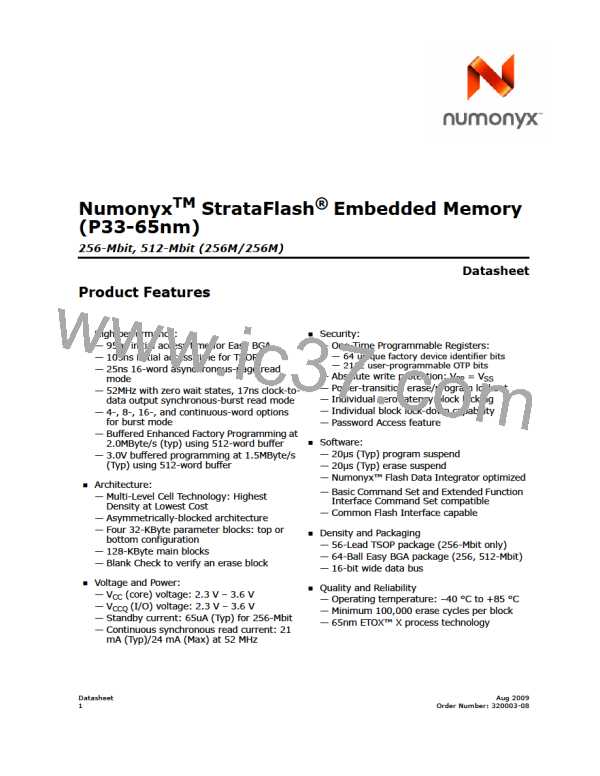P33-65nm
6.0
Command Set
6.1
Device Command Codes
The system Central Processing Unit provides control of all in-system read, write, and
erase operations of the device via the system bus. The on-chip WSM manages all block-
erase and word-program algorithms.
Device commands are written to the CUI to control all flash memory device operations.
The CUI does not occupy an addressable memory location; it is the mechanism through
which the flash device is controlled. Table 6 shows valid device command codes and
descriptions.
Table 6:
Command Codes and Definitions (Sheet 1 of 2)
Mode
Code
Device Mode
Read Array
Description
0xFF
Places the device in Read Array mode. Array data is output on DQ[15:0].
Read Status
Register
Places the device in Read Status Register mode. The device enters this mode
after a program or erase command is issued. SR data is output on DQ[7:0].
0x70
0x90
Read Device ID
or Configuration
Register
Places device in Read Device Identifier mode. Subsequent reads output
manufacturer/device codes, Configuration Register data, Block Lock status,
or OTP register data on DQ[15:0].
Read
Places the device in Read Query mode. Subsequent reads output Common
Flash Interface information on DQ[7:0].
0x98
0x50
Read Query
Clear Status
Register
The WSM can only set SR error bits. The Clear Status Register command is
used to clear the SR error bits.
First cycle of a 2-cycle programming command; prepares the CUI for a write
operation. On the next write cycle, the address and data are latched and the
WSM executes the programming algorithm at the addressed location. During
program operations, the device responds only to Read Status Register and
Program Suspend commands. CE# or OE# must be toggled to update the
Status Register in asynchronous read. CE# or ADV# must be toggled to
update the SR Data for synchronous Non-array reads. The Read Array
command must be issued to read array data after programming has finished.
Word Program
Setup
0x40
This command loads a variable number of words up to the buffer size of 512
words onto the program buffer.
0xE8
0xD0
Buffered Program
Write
The confirm command is Issued after the data streaming for writing into the
buffer is done. This instructs the WSM to perform the Buffered Program
algorithm, writing the data from the buffer to the flash memory array.
Buffered Program
Confirm
First cycle of a 2-cycle command; initiates the BEFP mode. The CUI then
waits for the BEFP Confirm command, 0xD0, that initiates the BEFP
algorithm. All other commands are ignored when BEFP mode begins.
0x80
0xD0
BEFP Setup
If the previous command was BEFP Setup (0x80), the CUI latches the
address and data, and prepares the device for BEFP mode.
BEFP Confirm
First cycle of a 2-cycle command; prepares the CUI for a block-erase
operation. The WSM performs the erase algorithm on the block addressed by
the Erase Confirm command. If the next command is not the Erase Confirm
(0xD0) command, the CUI sets Status Register bits SR [5,4], and places the
device in Read Status Register mode.
0x20
0xD0
Block Erase Setup
Erase
If the first command was Block Erase Setup (0x20), the CUI latches the
address and data, and the WSM erases the addressed block. During block-
erase operations, the device responds only to Read Status Register and Erase
Suspend commands. CE# or OE# must be toggled to update the Status
Register in asynchronous read. CE# or ADV# must be toggled to update the
SR Data for synchronous Non-array reads.
Block Erase Confirm
Datasheet
17
Aug 2009
OrderNumber:320003-08

 MICRON [ MICRON TECHNOLOGY ]
MICRON [ MICRON TECHNOLOGY ]